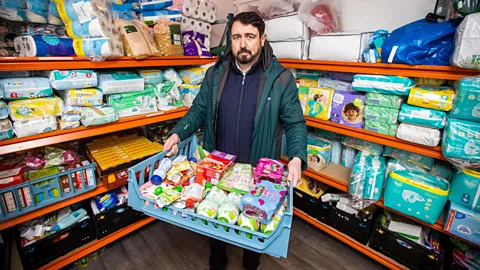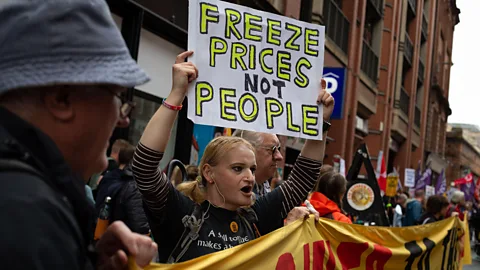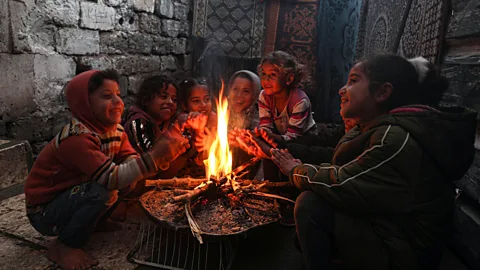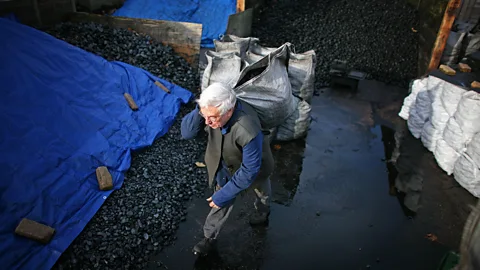Energy crisis: How living in a cold home affects your health
 Wolfgang Schwan/Getty Images
Wolfgang Schwan/Getty ImagesWith the world in the grip of a global energy crisis, hundreds of millions of people are now facing fuel poverty this winter as they struggle to keep their homes warm. The consequences could be wide-reaching and long-lasting, finds Chris Baraniuk.
On the coldest mornings, Mica Fifield doesn't need an alarm clock. The pain in her joints wakes her up. Her legs and knees hurt the most. Lying there, she knows that there are things to do around the house. But it's hard to get out of bed. The heating in her terraced home in Lancashire, England, is off. The dormant radiators, pinned to their walls, sit there, chilly to the touch. There's condensation around the windows. And the pain digs in so much more now the weather is turning.
"We don't touch the heating whatsoever," says Fifield, explaining how the price of her gas and electricity have gone up recently. She and her husband aren't sure exactly what it will cost them to put the heating on and they don't have the luxury of finding out. She just says: "We're too scared."
It's still early in the autumn when we speak. And although temperatures will only drop further in the coming months, the couple currently plan to keep their heating off for the entire winter, if they can.
Fifield is 27 and suffers from a form of Ehlers-Danlos syndrome, which in her case causes chronic pain. She also has some other conditions including costochondritis – inflammation around the bones in her chest. It makes it feel like she's having a heart attack, she explains. It causes pain and the sensation of something weighing down on her chest. A few years ago, she had planned to work in physical theatre and teach Zumba, but that all changed with her diagnosis. She is unable to work but receives benefits from the government while her husband works part-time and helps to care for her.
The energy crisis currently blighting the lives of so many around the world is taking its toll on some of the most fundamental activities of life. When Fifield goes to the kitchen to make dinner, for example, she rarely puts the oven on – the air fryer consumes less energy. Fifield also worries about whether she'll be able to charge up her mobility scooter enough to get about. She likes to go to the swimming pool four times a week, since that helps her pain – and because that's where she can get a hot shower.
Despite these challenges, Fifield doesn't feel sorry for herself, she says. That's not how she views her situation. But she does say she wants to raise awareness around chronic pain and how living in a cold home can make it so much worse.
Fifield's story of hardship and resilience is just one of millions that are likely to unfold this winter. Thanks to rising fuel and electricity bills, many other people around the world could be forced to make difficult choices about when, or if, they turn on their heating.
Elderly people will wrap themselves in coats, scarves and gloves to sit in their living rooms. Parents will worry about whether their babies are warm enough, as they add an extra blanket to their cots. Gas fires will go unlit. Electric heaters will be left, impounded, at the back of cupboards. Couples will argue about whether now – now! – is the time to adjust the thermostat and fire up the boiler at last. There's no choice. But no money to pay for it, either.
 Mica Fifield
Mica FifieldAn estimated 36 million people in Europe were unable to keep their homes adequately warm in 2020. In the US, 16% of the country experiences energy poverty, including 5.2 million households considered to be above the Federal Poverty Line. And in China, 24-27% of middle-aged and older adults are estimated to live in energy poverty.
With the volatile energy market sending prices soaring, and the possibility of blackouts and gas shortages looming, particularly in Europe, the situation could become even worse.
Although the price rises are most extreme in Europe, US consumers are not likely to be immune from elevated energy costs. The International Energy Agency (IEA) has warned that the world is in the midst of its first truly "global energy crisis" – largely triggered by Russia's invasion of Ukraine. Many millions of people are likely to be affected but the greatest burden will fall on the poorest and most vulnerable.
The health consequences of all this are not trivial. Scientific research makes clear that cold homes are harmful for their occupants and sometimes even deadly, too. There's a higher risk of stroke, respiratory infection and falls or other injuries due to people's reduced strength and dexterity in low temperatures. Cold homes can have both short and long-term consequences for a person's health, wellbeing and even their opportunities in life.
Now that the Northern Hemisphere's summer of 2022 is passing into memory, doctors are already speaking to patients concerned about chilly conditions in the coming months. Charity workers are directing funds to help the most vulnerable pay for a little heating each week. Some organisations are planning to hand out parcels of warm clothes or set up warm spaces to which people can travel, if they're able, to avoid shivering at home.
Some health experts argue that this is not just a fleeting moment of hardship. They say it is a public health dilemma. And we ignore it at our peril.
It is mid-morning at a foodbank in West Belfast, Northern Ireland. Carrier bags stuffed with food sit in rows on shelves, ready for delivery. There are boxes of breakfast cereal, tins of soup or beans. Packets of pasta. And nappies. Labouring by a shopping trolley filled to the brim with boxes of cooked ham, donated that morning by a local business, is Paul Doherty. He is a poverty campaigner, former political candidate and volunteer who founded an organisation called Foodstock, which runs this foodbank. He soon packs the ham into a large fridge.
Foodstock is one of several charitable organisations providing food aid in Belfast but it alone supports around 400 households, and numbers are rising, says Doherty. He and his fellow volunteers offer a lot more than food. There's help with benefits and free clothing, including school uniforms at certain times of year. Now that autumn has arrived, conversations with locals are increasingly turning towards the cost of heating.
"To be honest with you, it's people at their wit's end," he says. "You're seeing the worry and despair in their face."
He stresses that fuel poverty is not a new phenomenon. Earlier this year, he says he met an elderly man who, like Fifield plans to in the coming months, kept his heating off throughout the entire previous winter. Lately Doherty has had early morning calls from distressed parents. They've got up to get the kids ready for school. But the house is freezing.
"We're seeing whole families sitting round a dinner table wearing coats. That is a reality. I've seen that multiple times," he says. As we're talking, a smiling woman arrives and passes a paper envelope to Doherty. It's a financial donation that will go into a fund to help pay for people's heating, he explains after she leaves.
Health issues come up frequently in conversations in the community, he adds. He hears about children with asthma. People who say their mental health is suffering due to the unrelenting misery of living in a frigid house. They worry. They withdraw.
To fully understand why this is such a problem, it's important to get past the misconception some may have that a cold house is merely uncomfortable. Low temperatures affect the very functioning of our bodies, says Dame Margaret Whitehead, professor of public health at the University of Liverpool, in the UK.
Take blood as an example. When the mercury drops, our blood vessels narrow slightly. This raises blood pressure and hampers circulation. Our blood also becomes thicker, partly due to an increase in the levels of a protein called fibrinogen and other molecules that cause clotting. The ultimate consequence of these changes could be a stroke or heart attack.
 PA/Alamy
PA/AlamyPeople who have cancer, arthritis or certain disabilities can be particularly sensitive to the cold, adds Whitehead. But there are less obvious problems, too. Consider those who may choose to wear a coat indoors or a pair of gloves to keep the cold away.
"If you've got all sorts of layers on, it certainly would restrict your mobility," says Whitehead. For an elderly person, for example, that could increase the chance of having a fall or some other injury at home.
As for chronic pain, not everyone who experiences it reports worsened symptoms when it is cold, as Mica Fifield does, but there are plenty of examples. A 2016 case study described a woman with Ehlers-Danlos and other conditions who noticed that pain in her arm and nose was present mostly during spells of cold weather. Sitting at home on cold days certainly doesn't help, says Fifield. "If I'm doing something like reading or I'm holding my phone, the pain will start in my arm and then it kind of just spreads."
Besides the direct effects of low temperatures, other environmental factors in cold homes can impact people's health – such as damp and mould, which are more common in poorly heated houses.
The spores released by mould fungi irritate people's lungs and can exacerbate conditions such as asthma. One nine-year study showed that living in damp and mouldy conditions for long periods is significantly related to a decline in lung function, for example: how much air people can expel in one second of breathing out.
Children living in damp, mouldy houses have an increased risk of respiratory infections. This has worried public health experts given that some children's immunity might already be impaired as a result of the pandemic lockdowns.
Even the very youngest children are at risk. Ian Sinha, a consultant respiratory paediatrician, treats babies born preterm at Alder Hey Hospital in Liverpool, UK. Some of these babies require mechanical ventilation and are sent home with oxygen supplies on their original due date so long as they are ready to leave hospital.
You might also be interested in:
"You can't really envisage a more vulnerable group of children than that," he says on the phone to me, as he catches a few moments' break one afternoon in early November. At the time, he is running a busy clinic for babies like this who are now a little older and eligible for vaccination against bronchiolitis.
"We send them home to houses where there's structural problems with damp and mould or the house isn't warm enough," he adds, lamenting the health impacts poverty has on tiny bodies.
 Jeremy Sutton-Hibbert/Alamy
Jeremy Sutton-Hibbert/AlamyHidden energy poverty
The cold is not the only risk for those experiencing energy poverty. In the US, an estimated 500,000-600,000 low-income Americans rely on burning solid fuel such as coal or wood in their homes to stay warm, risking exposure to harmful indoor air pollution. Globally this kills an estimated 2.3-3.8 million people every year, particularly in developing countries. In England, firefighters have issued warnings after seeing a surge in incidents where residents have been burning fuel in open containers in their homes to stay warm, leading to at least one death.
In hot climates too, being unable to afford electricity bills means keeping cooling systems such as air conditioners turned off, which can put people at risk of health problems during heatwaves. One recent study in Arizona, US, found 10% of the 4,577 households it surveyed could be classed as energy-insecure or energy-poor.
Sinha says people in poverty may experience multiple compounding factors alongside a lack of heating that together can worsen their health significantly. It's often not just that the radiators are never on but also that there's no decent food to eat and the air quality indoors is bad as well, he explains.
The consequences can be fatal. A 2011 report from University College London's (UCL) Institute of Health Equity, known as the Marmot review, estimated that 21.5% of excess winter deaths in the UK were attributable to cold homes. The figure changes year after year but can equate to several thousand deaths in a single season. In 2020-21, for example, 63,000 excess winter deaths were recorded in England, 10% of which were estimated to be directly attributable to fuel poverty according to the latest edition of the Marmot Review, authored by Sinha and colleagues, which was published in September.
The review warned that around 15 million people in the UK – 55% of the country's households – could fall into fuel poverty by early 2023, which might not only result in thousands of additional deaths but would also "blight" the development of millions of children.
"There's a really complex web of things that leads to the increased rates of excess death but, ultimately, all roads lead back to poverty," Sinha says.
There is little doubt that cold homes can kill but they can also simply worsen people's overall health and affect their quality of life. One US study, published in 2019, found an association between colder weather and a rise in dementia-related hospitalisations.
Other research reveals just how widespread the connection between fuel poverty and poor health really is. Harriet Thomson, an expert in global social policy at the University of Birmingham, in the UK, published a paper in 2017 with colleagues that analysed data from a major survey across 32 European countries. A link between fuel poverty and poor health was clear, though this varied from nation to nation. An updated version of this research by Thomson, which has not yet been published, suggests that depression is closely associated with energy poverty and that this association was more pronounced in poorer countries. A separate study by researchers in China suggested that energy poverty has a significant detrimental impact on people's mental health.
"If there's someone in the household with a chronic illness or disability, there are much higher rates of fuel poverty," says Thomson. "We're seeing that across the board."
Certain ethnic minorities may be more prone to such problems, adds Thomson – not least because many minorities are often at greater risk of poverty to begin with. But take people of a Black African or Black Caribbean background, who are much more likely to have sickle cell disease. This term refers to multiple conditions in which people's red blood cells are unusually shaped. Sometimes that leads to painful episodes called sickle cell incidents or crises.
"Cold is a trigger for a sickle cell incident," says Thomson. A 2015 review found that it was "very real" for people with sickle cell disease, was widely reported by patients and also mentioned in textbooks. However, the authors added that there was "surprisingly little" scientific evidence to explain exactly how temperature or temperature changes might affect sickle cell incidents.
One physician who says lower temperatures have a "very direct impact" on sickle cell crises, is Ronny Cheung, a consultant paediatrician in London. The patients who visit his clinic come from diverse backgrounds and income brackets. He says he has already spoken to parents this autumn who are upset over the fact that they have not been able to heat their homes as much as they feel is necessary. "This is a very real thing that we're seeing," says Cheung, recalling one who recently burst into tears in his office as she described her situation.
All of the above problems are on Cheung's mind, he says, but so too is the fact that fuel poverty can derail children's development in other ways and have potential long-term consequences. For example, young people from low income households might miss out on school if their health suffers during cold spells.
"You can't get that time back," says Cheung. In a 2009 study in New Zealand, researchers installed heating devices that boosted temperatures in the homes of hundreds of children with asthma over winter. Compared to the control group, those children experienced 21% fewer days of absence, on average. Other research has shown that children from families experiencing energy poverty tend to do less well in school in general, and also suffer from bullying, stigma and social isolation.
Tammy Boyce, one of the lead authors of this year's updated Marmot review from UCL's Institute of Health Equity, on the health effects of fuel poverty, says that living in a cold home during childhood can ripple across the rest of a person's life.
Currently, families that can afford a little heating might be restricting it to a single room in a household, she suggests.
"What does that mean for young people trying to do homework? Or different members of the family being forced to live in one room or two rooms?" asks Boyce. The answer is poorer mental health and educational outcomes, among other problems, according to her and her colleagues' research. (Listen to this episode of Inside Health for more about how the cold affects your body.)
 Mustafa Hassona/Getty Images
Mustafa Hassona/Getty ImagesAnd there's the emotional toll all of this takes, too.
"We've got families actually turning their cookers off, their televisions, their heating. The only thing they've got on is a fridge," says Billy McGranaghan, founder of Dad's House, a charity supporting single fathers in the UK. He also runs two foodbanks, open to anyone, in London.
"It's destroying a lot of families' relationships," he adds. Some households are "walking on eggshells" because there's no money to pay for a child's much-needed new shoes, for example. While tensions rise, parents watch the money in prepayment gas meters tick steadily downwards, knowing that the heating will soon run out again, McGranaghan says.
He can tell that the people he speaks to are embarrassed about this. That they feel anxious. He says it's obvious from their tone of voice, their body language.
With the harshest months of winter still ahead, the outlook seems very bleak. But there are people, like McGranaghan, who are trying to help.
Back in Belfast, on a second visit to Foodstock, I meet Doherty outside a small church hall on a quiet residential street. The church leaders have loaned him the key and, when the metal shutter rolls up and he opens the door, we step inside to an incredible bounty of heat.
"It's really warm in here," I remark, genuinely startled at how toasty the room is. "Yeah, it's a great system – that was the thinking behind using here, it's great," says Doherty, pacing across the floor enthusiastically. The heat radiates from below. It must be 23C (73F) at least, I estimate, loosening my scarf.
In just a few weeks, this will be the site of what Doherty describes as a warm community space. Every Monday, the venue will be open to locals, including those who aren't able to heat their homes. A nearby supermarket has promised to donate buns and cakes. Doherty excitedly explores the kitchen to one side of the hall where people will be able to make coffee and tea. There'll be arts and crafts and other activities so visitors will have lots of reasons to come and enjoy the warmth. He and his fellow volunteers are organising two additional warm spaces besides this one.
The prospect of so-called "warm banks" springing up in places across the UK this winter, including in public libraries, churches and galleries, has prompted disbelief from some members of the public. But Doherty says the need is real. Many of the people Foodstock supports live alone in cold houses, he explains. A warm, friendly space provides a sociable alternative. (People in the UK looking for warm places to use over the winter can now find examples of such sites near to them via a virtual map, set up by the Warm Welcome Initiative.)
Doherty has also spent the summer stockpiling donations of winter clothes – fleeces, thermal underwear, coats, scarves, gloves and more to be packed in tote bags and distributed to people in the community. This won't be the first year Foodstock has distributed "warm packs" but demand could be particularly high this winter, Doherty says.
These are more or less emergency interventions. Perhaps the only things some people will have to prevent them from freezing at home. The British government has also offered financial assistance, to a point, with energy bills and organisations such as the Fuel Bank Foundation offer pre-paid top-up cards via local retailers for people who have run out of money for gas, for example. Matthew Cole, head of Fuel Bank Foundation, says he has already noticed soaring demand well before the arrival of winter.
Changing attitudes towards heating, in which it is increasingly viewed as a luxury, concern him, he adds: "This acceptance that it's OK now to be without energy, that's the norm – that worries me, actually, because it's not normal."
 Christopher Furlong/Getty Images
Christopher Furlong/Getty ImagesIt is worth remembering that, instead of emergency interventions, improving the fabric of people's homes, and the heating systems within them, can have a significant effect, says Jörg Huber at the University of Brighton.
He and colleagues published a study earlier this year that detailed the responses of nearly two dozen people in Hastings, England, who took part in a scheme that supplied better heating or insulation to properties in the town. In total, 149 people benefitted from the project. Some received draught proofing or a new boiler, for instance.
"We heard from people saying that this scheme really made a huge difference in that their home became again a place where they could receive guests… a friend or a neighbour coming round for a cup of tea or coffee or the like," he says. "That was very powerful, really."
Participants also said their homes were more comfortable than before and some noticed fewer respiratory infections or reduced pain.
Christine Liddell, professor emeritus at Ulster University, Northern Ireland, was the lead author of a 2010 study that reviewed a swathe of evidence into the health effects of fuel poverty.
She says that she would like fuel poverty to be viewed more broadly as a public health issue, and one for which governments are ultimately responsible. "In the same way they have responsibility for addressing the effects of smoking," she says.
Finally, legislation might also help. Landlords could be required to provide accommodation that meets a higher level of energy efficiency than is currently mandated, she suggests.
In Lancashire, Mica Fifield awaits the coming winter with trepidation. In the extreme cold, she and her husband may find they need to turn on their heating simply to prevent water freezing inside the pipes and causing leaks. "There might be a time when we don't have a choice," she admits.
Extreme cold snaps aside, she intends to manage her pain and the impact of low temperatures with warm clothes, a hearty blanket and devices such as a small electrical heat pad instead. It's a situation she says she has never experienced before in her life.
Fifield is already well aware of the consequences this will have on her health and wellbeing. And while she is determined to carry on, without any self-pity, she can't help but contemplate how things could be different. If it weren't for the price of gas. The cost of living crisis. This unforgiving British weather.
"It would be lovely to be like it was before," she says, "and be able to think I could put my heating on for a few hours."
--
